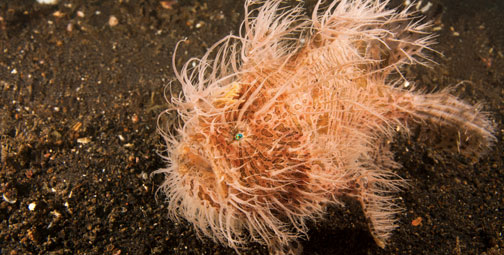They are predominantly concentrated in the Atlantic, Pacific and Indian Oceans, and exist the Red Sea as well. Frogfish live around coral and rock reefs up to a hundred meters deep and prefer a water temperature of at least twenty degrees Celsius.

The length of the average frogfish ranges from one to fifteen inches. Their stocky bodies are not covered in scales; instead they are covered with spindles. The frogfish’s spine has eighteen to twenty three vertebrae and its body has three different types of fins. The colors of the frogfish are usually sold white, yellow, red, green, or black. However, the most incredible thing about the frogfish is it natural ability to change its colors and display a combination of these colors on their bodies.
The spindles that cover the frogfish aid in the intimidation of potential predators. This type of defense mechanism is called aggressive mimicry. The frogfish’s ability to change the color of its body is a big advantage because it helps them camouflage and blend into their surroundings. This function helps them to both hide from predators as well as to hunt for its prey.
Frogfish are generally idle in nature. What movement they do make is visible only when hunting for food. The hunting action of a frogfish is quite interesting. After spotting its victim, a frogfish drifts toward it very slowly. As it approaches its prey, the frogfish attacks very swiftly. Within a millisecond, the prey is swallowed up and the frogfish continues to drift away slowly as if nothing had happened.
The reproductive system of frogfish is still under research. Most species of frogfish are free spawning, which means that the female frogfish lays eggs and the male member of the clan fertilizes the eggs. On average, a healthy frogfish can hold more than 180,000 eggs at a time. The eggs vary from 0.02 to 0.04 inches in size. It takes up to five days for a female frogfish to hatch their eggs.

